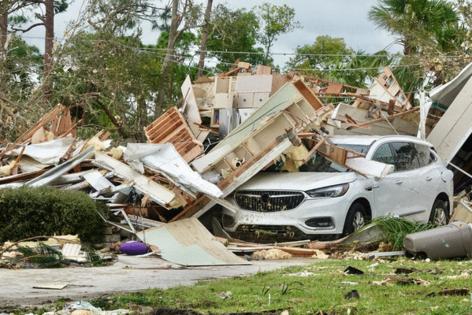Mark Gongloff: Helene and Milton damage is just the start of the climate tab
Published in Op Eds
When we think about the economic damage of climate change, most of us probably think about the physical destruction wrought by mammoth disasters like hurricanes, wildfires and droughts: Bungalows tumbling into the sea. Houses turned to ash. Acres of dead crops. That sort of thing. But the quieter, longer-term effects of global warming cut even deeper.
Consider western North Carolina. It’s just beginning to repair the heavy physical damage to homes, businesses and infrastructure caused by Hurricane Helene nearly a month ago. The state’s tab for that could be $53 billion, Governor Roy Cooper has said. But all of that physical wreckage also means businesses are closed, tourists aren’t visiting, people aren’t working, and few are splurging on luxury goods when many are still struggling just to get drinking water. That adds up to financial damage that dwarfs the physical one.
The total short- and long-term economic impacts of Hurricanes Helene and Milton could amount to roughly $400 billion, the private forecasting firm AccuWeather has estimated. That’s more than twice most assessments of the direct physical damage done by these storms.
Clearing away wreckage could take months. Rebuilding homes, businesses and infrastructure could take years. During that time, the economic losses will pile up, AccuWeather’s chief meteorologist, Jon Porter, noted in an interview. Businesses will close. People will move away forever.
“These places have a long road ahead,” Porter said. “They need a lot of help to rebuild and put lives back together, which tragically changed forever, sometimes in a matter of minutes.”
North Carolina’s pain will also be shared across the country in the form of higher grocery bills. Helene and Milton disrupted agriculture across the Southeast, tightening produce, livestock and fertilizer supplies when consumers are already struggling with food inflation.
Most insidiously, the stress of the disasters will inflict long-term health impacts on millions. Tropical storms cause excess deaths for 15 years after they strike, according to a new study by researchers at the University of California, Berkeley. The average storm leads to 7,000 to 11,000 extra deaths during that span, compared with the 24 deaths, on average, storms cause directly when they land. This doesn’t account for the chronic health problems of those who survive or the medical costs they will incur during their lifetimes.
But the pain doesn’t end there. S&P Global Ratings last week put Asheville and 11 other North Carolina and Tennessee municipalities on “CreditWatch with negative implications,” which is rating company lingo for “We might cut your credit rating.” Why? All of that aforementioned post-hurricane economic weakness could make it harder for these cities and towns to pay their bills. As anybody who has ever tried to buy a car with a lousy credit score can attest, this can balloon your borrowing costs. So add higher interest rates to a bill that is growing longer than a CVS receipt.
Disasters aren’t the climate’s only source of financial pain. A group of Oregon economists called the Forum on Oregon Climate Economics recently tried to tally all the losses a heating planet is inflicting on their state. As you would expect, they found the 2018 wildfire season and 2021 heat wave wreaked billions of dollars in damage. But Oregonians also lose tens of billions every year because of excess heat, poor air and water quality and other routine impacts of climate change, and they risk losing even more from the death of the state’s salt marshes, Douglas firs and other natural resources.
“The average household in Oregon can reasonably expect to suffer damages in the tens of thousands of dollars per year under current emissions scenarios,” the economists wrote.
And that’s just one state. All across the U.S. and the world, increasingly extreme climate conditions are hurting buildings and infrastructure in subtle but devastating ways, Bloomberg’s CityLab noted recently. Heat and rainfall that were unimaginable at the time of design and construction are causing roofs and HVAC systems to fail, roads and railways to buckle and foundations and plumbing to shift and crack. Maintenance and repair costs have only begun to soar.
All of this adds up to crushing economic cost. Every 1 degree Celsius of heating above pre-industrial averages cuts global GDP by 12%, a recent National Bureau of Economic Research paper estimated. The 1.3C of warming the planet has already experienced has left economic output 37% lower already than it might have been in a normal climate. By the end of the century, global GDP could be cut in half — an effect comparable to a permanent state of war.
In fact, war is a good analogy for the challenge we face. Bloomberg NEF has estimated it will cost $215 trillion by 2050 to mitigate future climate change and adapt to the warming already in the pipeline. If Earth faced an alien invasion that was costing it trillions of dollars and thousands of human lives every year and eroding the foundations of society, we wouldn’t blink at spending $215 trillion to repel it. The war against climate change is no less existential.
_____
This column does not necessarily reflect the opinion of the editorial board or Bloomberg LP and its owners.
Mark Gongloff is a Bloomberg Opinion editor and columnist covering climate change. He previously worked for Fortune.com, the Huffington Post and the Wall Street Journal.
_____
©2024 Bloomberg L.P. Visit bloomberg.com/opinion. Distributed by Tribune Content Agency, LLC.




























































Comments